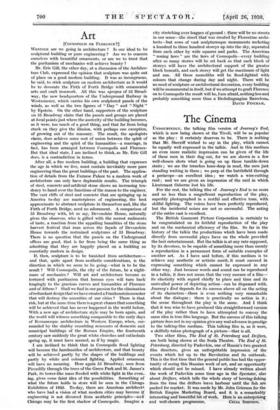Art
[COSMOPOLIS OR FLORENCE?]
WHITHER are we going in architecture ? Is our ideal to be sculptural building or pure engineering ? Are we to concern ourselves with beautiful ornaments, or are we to trust that the puritanism of Mechanics will achieve beauty ?
Mr. Eric Gill, the other day, at a discussion of the Architec- ture Club, expressed the opinion that sculpture was quite out of place on a good modern building. It was as incongruous, he said, to stick sculpture on modern architecture as it would be to decorate the Firth of Forth Bridge with ornamental arts and craft ironwork. All this was apropos of 55 Broad- way, the new headquarters of the Underground Railway in Westminster, which carries his own sculptured panels of the winds, 'as well as the two figures of " Day " and " Night " by Epstein. On the other hand, supporters of the sculpture on 55 Broadway claim that the panels and groups are placed at focal points just where the austerity of the building becomes, as it were, too much of a good thing, and that far from being stuck on they give the illusion, with perhaps one exception, of growing out of the masonry. The result, the apologists claim, does achieve some sort of union between the. spirit of engineering and the spirit of the humanities—a marriage, in fact, has been arranged between Cosmopolis and Florence. But that ideal state, I am inclined to think, as Mr. Eric Gill does, is a contradiction in terms.
After all, a fine modern building, a building that expresses the age in which we live, must contain inevitably more pure engineering than the great buildings of the past. The applica- tion of details from the Farnese Palace to a modern work of architecture can only have deplorable results. The triumph of steel, concrete and artificial stone shows an increasing ten- dency to hand over the functions of the mason to the engineer, The vast cliffs of steel and concrete that are springing up in America to-day are masterpieces of engineering, the best approximate to abstract sculpture in themselves and, like the Firth of Forth Bridge, need no adornment. A comparison of 55 Broadway with, let us say, Devonshire House, naturally gives the observer, who is gifted with the merest rudiments of taste, a reaction from the appalling banalities of the stone harvest festival that runs across the façade of Devonshire House towards the restrained sculptures of 55 Broadway. There is no question that the panels on the Underground offices are good, that is far from being the same thing as admitting that they are happily placed on a building so essentially modern in design.
If, then, sculpture is to be banished from architecture— and that, quite apart from aesthetic considerations, is the direction in which we seem to be going—what is to be the result ? Will Cosmopolis, the city of the future, be a night- mare of mechanics ? Will art and architecture become so tortured with puritanism that human eyes will turn back longingly to the gracious curves and humanities of Florence and of Athens ? Shall we find in our passion for the elimination of redundant design that we have created a Frankenstein monster that will destroy the amenities of our cities ? There is that risk, but at the same time there is a great chance that something
will be achieved that has never happened in the world before. With a new age of architecture style may be born again, and the world will witness something comparable to the early days of Romanesque, architecture in Western Europe, when, stir-- rounded by the shabby crumbling remnants of domestic and municipal buildings of the Roman Empire, the fourteenth century saw suddenly the great white churches and cathedrals spring up, it must have seemed, as if by magic.
I am inclined to think that in Cosmopolis flood lighting will become the handmaiden of architecture, and that beauty will be achieved partly by the shapes of the buildings and
partly by white and coloured lighting. Applied ornament, will have no mewling. Here again 55 Broadway, seen from
Piccadilly through the trees of the Green Park and St. James's Park, its tower-like mass flooded with white light in the even... ing, gives some faint idea of the possibilities. Something of what the future holds in store will be seen in the Chicago Exhibition of 1988. To-day, there are American architects, who have had a vision of what modern cities may become if: engineering is not divorced from aesthetic principles—and' Chicago may be the first shadow of Cosmopolis. Imagine a
city stretching over leagues of ground : there will be no streets in our sense—the street' that was Created by Florentine archi- tects—but rows of vast sculpturesque monuments rocketing a hundred to three hundred storeys up into the sky, separated from each other by wide squares and parks. The American " zoning laws " are the laws of Cosmopolis—every building after so many stories will be set back so that each block of storeys will have the architectural support of the greater block beneath, and each storey will get the maximum of light and sun. All these monoliths will be flood-lighted with colours that change during day and night. There will be no need of sculpture or architectural decoration, every building will be monumental in itself, but if we attempt to graft Florence on to Cosmopolis the result will be, I am afraid, nothing less and probably something more than a Brobdingnagian Barcelona,
DAVID FINCHAM,




































 Previous page
Previous page